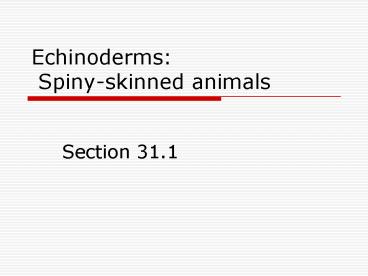Echinoderms: Spiny-skinned animals - PowerPoint PPT Presentation
1 / 15
Title:
Echinoderms: Spiny-skinned animals
Description:
Echinoderms: Spiny-skinned animals Section 31.1 Animal Development Echinoderms are related to vertebrates due to their early development The gastrula is the early ... – PowerPoint PPT presentation
Number of Views:120
Avg rating:3.0/5.0
Title: Echinoderms: Spiny-skinned animals
1
Echinoderms Spiny-skinned animals
- Section 31.1
2
Animal Development
- Echinoderms are related to vertebrates due to
their early development - The gastrula is the early embryo a hollow ball
of cells with an opening called a blastopore - Other animals are protostomes their mouth
develops first from or near the blastopore - Echinoderms and chordates (vertebrates) are
deuterostomes their anus develops from the
blastopore their mouth develops second from
another part of the gastrula
3
Development, continued
- First deuterostomes were marine echinoderms
- Also the first animals to develop endoskeletons
- Chordates (including all vertebrates) are
deuterostomes
4
Features of Modern Echinoderms
- Endoskeleton
- Calcium-rich
- Composed of plates called ossicles
- In adults the plates may fuse and hold spines
that protrude through the skin - Five-part radial symmetry
- Bilateral symmetry as larvae develop radial
symmetry as adults - Have no head or brain, only a central ring of
nerves with branches into each arm
5
Features, continued
- 3. Water-vascular system
- Made of interconnected canals and hollow tube
feet - The tube feet extend through the ossicles
- They are used for locomotion and feeding, as well
as some gas exchange and waste excretion - 4. Coelomic circulation respiration
- The body cavity acts as a simple circulatory and
respiratory system - Skin gills may grow along the spines to increase
surface area
6
Echinoderm Diversity
- Sea Stars
- Mostly carnivores
- Brittle Stars
- The largest class of echinoderms
- Have slender, branched arms
- Most are filter feeders
- Sea Lilies and Feather Stars
- Most primitive echinoderms
- Their mouth is located on their upper surface
- Usually sessile
7
Sea Stars
8
Brittle Stars
9
Sea Lilies
10
Feather Star
11
Diversity, continued
- Sea Urchins and Sand Dollars
- Lack distinct arms
- Flattened bodies with protruding spines that may
have poison - Sea Cucumbers
- Soft and slug-like
- Ossicles are not fused
- Sea Daisies
- Small group, discovered in deep water
12
Sea Urchin
13
Sand Dollar
14
Sea Cucumber
15
Sea Daisy































